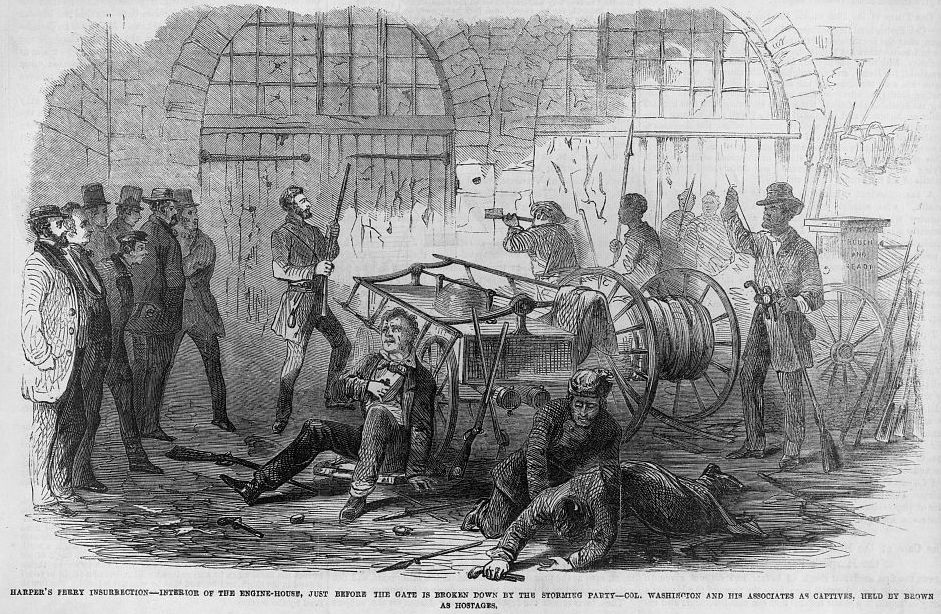|
Blue Ridge Mountain
Blue Ridge Mountain, also known as Blue Mountain, is the colloquial name of the westernmost ridge of the Blue Ridge Mountains in northern Virginia and the Eastern Panhandle of West Virginia. The Appalachian Trail traverses the entire length of the mountain along its western slope and crest. Geography The mountain extends from the Potomac River in the north to Chester Gap in the south. Along this section of the Blue Ridge Mountains, Blue Ridge Mountain comprises the sole ridge of the chain in the immediate vicinity and contains few spur ridges or peaks. The notable exceptions are the Bull Run and Catoctin mountains, which lie approximately to the east across the Loudoun Valley, and Short Hill Mountain, located to the east, which runs parallel to the Blue Ridge for near its northern terminus. To the west of the mountain is the lower Shenandoah Valley. Blue Ridge Mountain is noticeably lower in elevation than other sections of the Blue Ridge Mountains in Virginia. The southern ... [...More Info...] [...Related Items...] OR: [Wikipedia] [Google] [Baidu] |
Potomac River
The Potomac River () drains the Mid-Atlantic United States, flowing from the Potomac Highlands into Chesapeake Bay. It is long,U.S. Geological Survey. National Hydrography Dataset high-resolution flowline dataThe National Map. Retrieved August 15, 2011 with a drainage area of 14,700 square miles (38,000 km2), and is the fourth-largest river along the East Coast of the United States and the 21st-largest in the United States. Over 5 million people live within its watershed. The river forms part of the borders between Maryland and Washington, D.C. on the left descending bank and between West Virginia and Virginia on the right descending bank. Except for a small portion of its headwaters in West Virginia, the North Branch Potomac River is considered part of Maryland to the low-water mark on the opposite bank. The South Branch Potomac River lies completely within the state of West Virginia except for its headwaters, which lie in Virginia. Course The Potomac River runs ... [...More Info...] [...Related Items...] OR: [Wikipedia] [Google] [Baidu] |
Jefferson County, West Virginia
Jefferson County is located in the Shenandoah Valley in the Eastern Panhandle of West Virginia. It is the easternmost county of the U.S. state of West Virginia. As of the 2020 census, the population was 57,701. Its county seat is Charles Town. The county was founded in 1801, and today is part of the Washington metropolitan area. History Formation Jefferson County was established oOctober 26, 1801from Berkeley County because the citizens of southeastern Berkeley County felt they had to travel too far to the county seat of Martinsburg. Charles Washington, the founder of Charles Town and brother to George Washington petitioned for a new county to be formed. It was named for Thomas Jefferson, author of the Declaration of Independence and third President of the United States. Virginia previously had a Jefferson County, which is now part of Kentucky. Accordingly, in the State records of Virginia, there are listings for Jefferson County from 1780 to 1792 and Jefferson County from 1 ... [...More Info...] [...Related Items...] OR: [Wikipedia] [Google] [Baidu] |
Mount Weather
The Mount Weather Emergency Operations Center is a government command facility in the U.S. Commonwealth of Virginia, used as the center of operations for the Federal Emergency Management Agency (FEMA). Also known as the High Point Special Facility (HPSF), its preferred designation since 1991 is "SF." The facility is a major relocation site for the highest level of civilian and military officials in case of national disaster, playing a major role in continuity of government (per the U.S. Continuity of Operations Plan). Mount Weather is the location of a control station for the FEMA National Radio System (FNARS), a high frequency radio system connecting most federal public safety agencies and the U.S. military with most of the states. FNARS allows the president to access the Emergency Alert System. The site was brought into the public eye by ''The Washington Post'', which mentioned the government facility in its coverage following the December 1, 1974 crash of TWA Flight 514, a ... [...More Info...] [...Related Items...] OR: [Wikipedia] [Google] [Baidu] |
Raven Rocks (rock Formation)
Raven Rocks is spur of Blue Ridge Mountain in Jefferson County, West Virginia. The peak is located just north of Jefferson County's border with Clarke County, Virginia and west of its border with Loudoun County, Virginia. Raven Rocks is formed by the drainage gorges of Rocky Branch Creek to the north and Raven Rocks Creek to the south (both direct tributaries of the Shenandoah River) on the mountains western watershed. Raven Rocks is the northernmost spur in a series spurs and hollows that occur along the western slope of Blue Ridge Mountain south to Ashby Gap. The formation is often referred to as ''the rollercoaster'' by Appalachian Trail The Appalachian Trail (also called the A.T.), is a hiking trail in the Eastern United States, extending almost between Springer Mountain in Georgia and Mount Katahdin in Maine, and passing through 14 states.Gailey, Chris (2006)"Appalachian ... hikers as the trail undulates between these spurs and hollows along the western face of ... [...More Info...] [...Related Items...] OR: [Wikipedia] [Google] [Baidu] |
Purcell Knob
Purcell Knob is a spur of the Blue Ridge Mountain in Loudoun County, Virginia. The peak is just northeast of the main ridge at Keyes Gap and southeast of the village of Neersville. Purcell Knob is notable for exposure of the sericitic phyllite base of the Paleozoic The Paleozoic (or Palaeozoic) Era is the earliest of three geologic eras of the Phanerozoic Eon. The name ''Paleozoic'' ( ;) was coined by the British geologist Adam Sedgwick in 1838 by combining the Greek words ''palaiós'' (, "old") and ' ... Loudoun Formation in its antiformal syncline. References Mountains of Virginia Mountains of Loudoun County, Virginia Blue Ridge Mountains {{LoudounCountyVA-geo-stub ... [...More Info...] [...Related Items...] OR: [Wikipedia] [Google] [Baidu] |
Sky Meadows State Park
Sky Meadows State Park is a park in the Virginia state park system. It is located in extreme northwest Fauquier County, Virginia in the Blue Ridge Mountains, near Paris, Virginia. It is about an hour outside of the Washington, D.C. metro region. History and amenities The park was formed when Paul Mellon donated of land in 1975. The name Sky Meadows came from former owner Sir Robert Hadow, who named the property "Skye Farm" after an island in Scotland. It has expanded its borders twice since then— were added in 1987, containing the Appalachian Trail, and in 1991 Mellon donated an additional , bringing the park to its present size. It is located near Paris, Virginia off US 17, south of US 50 and north of Interstate 66. It starts in a valley between the foothills and the Blue Ridge Mountains, then has meadows and forests stretching up to the ridge of the mountain and the Appalachian Trail. There is a basic walk-in campground, over of hiking trails and of bridle paths. The ... [...More Info...] [...Related Items...] OR: [Wikipedia] [Google] [Baidu] |
Harpers Ferry National Historical Park
Harpers Ferry National Historical Park, originally Harpers Ferry National Monument, is located at the confluence of the Potomac River, Potomac and Shenandoah River, Shenandoah rivers in and around Harpers Ferry, West Virginia. The park includes the historic center of Harpers Ferry, notable as a key 19th-century industrial area and as the scene of John Brown (abolitionist), John Brown's failed Abolitionism in the United States, abolitionist uprising. It contains the most visited historic site in the state of West Virginia, John Brown's Fort. The park includes land in the Shenandoah Valley in Jefferson County, West Virginia, Jefferson County, West Virginia; Washington County, Maryland, Washington County, Maryland and Loudoun County, Virginia, Loudoun County, Virginia. The park is managed by the National Park Service, an agency of the U.S. Department of the Interior. Originally designated Harpers Ferry U.S. National Monument, National Monument in 1944, the park was declared a Nationa ... [...More Info...] [...Related Items...] OR: [Wikipedia] [Google] [Baidu] |
Alleghenian Orogeny
The Alleghanian orogeny or Appalachian orogeny is one of the geological mountain-forming events that formed the Appalachian Mountains and Allegheny Mountains. The term and spelling Alleghany orogeny was originally proposed by H.P. Woodward in 1957. The Alleghanian orogeny occurred approximately 325 million to 260 million years ago over at least five deformation events in the Carboniferous to Permian period. The orogeny was caused by Africa's collision with North America. At the time, these continents did not exist in their current forms: North America was part of the Euramerica super-continent, while Africa was part of Gondwana. This collision formed the super-continent Pangaea, which contained all major continental land masses. The collision provoked the orogeny: it exerted massive stress on what is today the Eastern Seaboard of North America, forming a wide and high mountain chain. Evidence for the Alleghanian orogeny stretches for many hundreds of miles on the surface from ... [...More Info...] [...Related Items...] OR: [Wikipedia] [Google] [Baidu] |
Catoctin Formation
The Catoctin Formation is a geologic formation that expands through Virginia, Maryland, and Pennsylvania. It dates back to the Precambrian and is closely associated with the Harpers Formation, Weverton Formation, and the Loudoun Formation. The Catoctin Formation lies over the a granite basement rock and below the Chilhowee Group making it only exposed on the outer parts of the Blue Ridge. The Catoctin Formation contains metabasalt, metarhyolite, and porphyritic rocks, columnar jointing, low-dipping primary joints, amygdules, sedimentary dikes, and flow breccias. Evidence for past volcanic activity includes columnar basalts and greenstone dikes. Stratigraphy Stratigraphy of the Catoctin Formation is closely related to the Harpers Formation, Weverton Formation, and the Loudon Formation. The Harpers Formation is part of the Chilhowee Group. This formation is found above the Weverton Formation and is around 2000–2750 feet in thickness. This formation contains gray phylli ... [...More Info...] [...Related Items...] OR: [Wikipedia] [Google] [Baidu] |
Greenschist
Greenschists are metamorphic rocks that formed under the lowest temperatures and pressures usually produced by regional metamorphism, typically and 2–10 kilobars (). Greenschists commonly have an abundance of green minerals such as chlorite, serpentine, and epidote, and platy minerals such as muscovite and platy serpentine. The platiness gives the rock schistosity (a tendency to split into layers.) Other common minerals include quartz, orthoclase, talc, carbonate minerals and amphibole (actinolite). Greenschist is a general field petrologic term for metamorphic or altered mafic volcanic rock. In Europe, the term ''prasinite'' is sometimes used. A ''greenstone'' is sometimes a greenschist but can also be rock types without any schistosity, especially metabasalt (spilite). However, basalts may remain quite black if primary pyroxene does not revert to chlorite or actinolite. To qualify for the name a rock must also exhibit schistosity or some foliation or layering. The rock i ... [...More Info...] [...Related Items...] OR: [Wikipedia] [Google] [Baidu] |
Granite
Granite () is a coarse-grained (phaneritic) intrusive igneous rock composed mostly of quartz, alkali feldspar, and plagioclase. It forms from magma with a high content of silica and alkali metal oxides that slowly cools and solidifies underground. It is common in the continental crust of Earth, where it is found in igneous intrusions. These range in size from dikes only a few centimeters across to batholiths exposed over hundreds of square kilometers. Granite is typical of a larger family of ''granitic rocks'', or ''granitoids'', that are composed mostly of coarse-grained quartz and feldspars in varying proportions. These rocks are classified by the relative percentages of quartz, alkali feldspar, and plagioclase (the QAPF classification), with true granite representing granitic rocks rich in quartz and alkali feldspar. Most granitic rocks also contain mica or amphibole minerals, though a few (known as leucogranites) contain almost no dark minerals. Granite is nearly alway ... [...More Info...] [...Related Items...] OR: [Wikipedia] [Google] [Baidu] |





